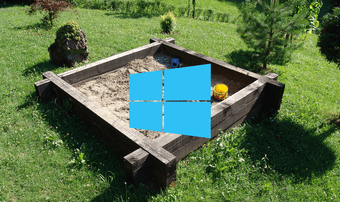Upon quitting the mode, Windows Sandbox will not save my settings, the programs that I install, or any downloaded files. That means I have to start from scratch every time. Not the ideal virtual machine to just pick up and resume. But this seemingly negative aspect is where the magic behind Windows Sandbox lies. If you are wondering as to what Windows Sandbox is best usable for, then let’s take a look at five instances where I make maximum use out of it.
1. Check for Malware
I can remember quite a few times where I excitedly got hold of a program, only to find out that it was infected with malware or adware. Thankfully the Windows Sandbox mode eliminates the antivirus application’s check any time you want to use a program. All I now do is copy and paste the program installer to Windows Sandbox, after which I can easily install it to check if it works as advertised. If everything looks clean, I can confidently install the program on the host operating system without worrying. And in the instance that a file is infected, I can safely exit Windows Sandbox, upon which it will shred everything. Windows Sandbox is fully isolated from the rest of the operating system, so nothing gets out without my permission.
2. Try Out Software
My work requires me to try out new software all the time. But that doesn’t mean that I want to keep holding onto them forever. That’s why, installing and removing many programs over time can seriously mess up the performance in Windows 10. Thankfully, this is where Windows Sandbox comes in real handy. I just install the program, do what I need to do, and then exit the Windows Sandbox. It’s that easy. No more cluttering my computer with leftover files and redundant registry entries.
3. Surf the Internet
My web browsing often takes me to the nether reaches of the internet, which is incredibly unsafe. Ant that’s why I rely on Windows Sandbox whenever I want to visit sketchy-looking websites. That way, I can stop worrying about cryptominers, hijackers, and other forms of unwanted scripts from permanently infiltrating the sanctity of my browser. However, I do make it a point to not sign into the web browser. While Google Chrome carries features such as Site Isolation to isolate tabs, there’s a possibility for a potential security loophole to be exploited. And leaving your personal data laying around won’t bode well in case that happens. Re-downloading Chrome (my go-to browser on Windows) isn’t always feasible each time I want to use Windows Sandbox. So for the most part, I end up using the built-in Edge browser instead, which isn’t all that bad.
4. Download Files
Aside from surfing the internet, Windows Sandbox also insulates me from dangerous file downloads. Whenever I see an iffy-looking Download link, I fire up Windows Sandbox and download it over there instead. That holds especially true for downloads where Chrome often throws out active warnings. I head over to Windows Sandbox, download the file, and even open it to check that there’s nothing suspicious. I can also move the downloaded file to the host operating system afterward, so it’s not like I’m wasting any bandwidth in the process either. I also scan it with my antivirus program for good measure. While I don’t do this, you can also download suspicious email attachments via Windows Sandbox to ensure that there’s nothing nasty inside.
5. Play with Windows Settings
Windows 10 has a lot of settings that I still find bewildering even after years of use. So rather than tinkering with them directly and ending up breaking some core functionality, I end up doing that on Windows Sandbox instead. That is also applicable to system-critical areas such as the Registry Editor. Whenever I have to meddle with the registry keys for my troubleshooting posts, I first try that out within the Windows Sandbox. That way, I won’t have to worry about breaking something up. If I do, all it takes is a simple reload of the Windows Sandbox to start over.
Unleash Yourself
Windows Sandbox is the perfect digital playground. Testing out new programs, initiating and verifying downloads, and messing around with the various Windows settings are things that you definitely should do with this fantastic implementation. However, I would throw caution to the wind. Everything has a loophole, so I wouldn’t actively go around testing out files that are known to contain malware. It still warrants taking active precautions. Next up: At times, Windows Sandbox may stop connecting to the internet. Learn what to do in case that happens. The above article may contain affiliate links which help support Guiding Tech. However, it does not affect our editorial integrity. The content remains unbiased and authentic.














